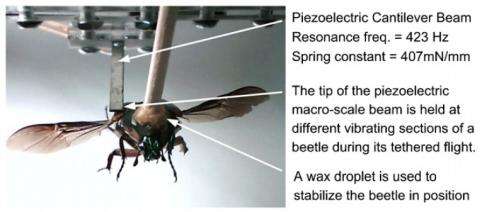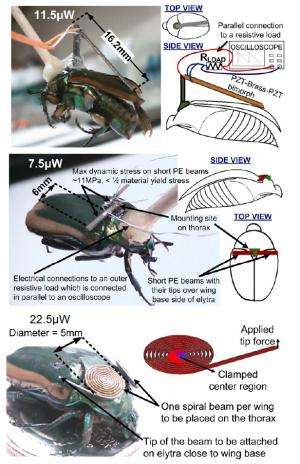August 31, 2011 feature
Cyborg insects generate power for their own neural control

(ĚÇĐÄĘÓƵOrg.com) -- For many years, researchers have been working on designing and fabricating micro-air-vehicles (MAVs), flying robots the size of small insects. But after realizing how difficult it is to create a tiny, lightweight flying vehicle capable of carrying a payload and being powered by a long-life onboard power source, some researchers have recently stopped trying to copy real-life insects and started using the insects themselves, with a few small tweaks. For instance, using tiny stimulators near their antennae, electrodes implanted in their central nervous systems, or neuromuscular interfaces, researchers have found that it’s easier to control insect’s brains – and therefore, flight – than to build robotic insects from scratch.
“Although we have seen a tremendous and exciting effort in MAV development in the last decade, cyborg insects are much more advantageous when it comes to the aerodynamic performance, flight duration, payload capability, and energy storage at miniaturized scales,” Ethem Erkan Aktakka from the University of Michigan told ĚÇĐÄĘÓƵOrg.com. “The current technology is simply not there yet to beat nature's evolution over several thousands of years.”
So far, the neural control systems in cyborg insects have generally been powered by batteries. But now Aktakka and coauthors Hanseup Kim and Khalil Najafi from the University of Michigan (Kim is currently with the University of Utah), have developed an energy scavenger that generates power from the wing motion of a Green June Beetle during tethered flight. Two generators – one on each of the beetle’s wings – use piezoelectric devices to produce a total of 45 µW of power per insect. The researchers predict that this power could be increased by an order of magnitude through a direct connection between the generator and the insect’s flight muscles.
The study, published in a recent issue of the Journal of Micromechanics and Microengineering, marks the first attempt to scavenge energy from live insects with non-resonant devices. Previous energy harvesting methods from insects have included using thermocouples to harvest the insect’s body heat and resonant magnetic devices to harvest vibration. Solar cells are also an alternative energy source, although their operation is limited to outdoor applications on sunny days. Since the flapping frequency of the beetles’ wings varies among individuals, and even for the same individual under different conditions, the scientists thought that a non-resonant device could have advantages for harvesting the broadband energy.

Here, the researchers experimented with piezoelectric cantilever beams on the insect’s wings and piezoelectric spiral beams on its thorax and elytra (wing covers). The devices could operate at 85-105 Hz, which is the flapping frequency range of the Green June Beetle. The spiral beams demonstrated the higher power at 45 µW, while the cantilever beams could produce about half that amount or less. Tests showed that the closer the scavenger devices are to the flight muscle base (the source of vibration), the higher the mechanical force from the beetle and the resulting electrical power output. Using a larger piezoelectric beam in one test, the researchers demonstrated that they could harvest 115 µW when at the optimum location.
“The developed device concept enables the practical deployment and extended operation of the same harvester on any individual of the same species, in addition to a great reduction in overall device weight compared to resonant harvesters,” Aktakka said. “A significant power output can be obtained regardless of several Hz of shift in the flapping frequency, or the ambient conditions such as light or temperature.”
The researchers note that cyborg insects could have the same applications as MAVs, which include search-and-rescue operations, surveillance, monitoring of hazardous environments, and detection of explosives.
“Currently, we are working on the development of a new micro-fabrication process for integration of bulk piezoelectric ceramics into traditional silicon processing,” Aktakka said. “This new technology helps to boost the efficiency of miniaturized vibration energy harvesters, compared to conventional thin-film deposition techniques. We also have ongoing studies on the power electronics side for effective utilization of raw power to recharge a battery or ultracapacitor.”
This project is funded by DARPA under Hybrid Insect MEMS program.
More information: Ethem Erkan Aktakka, et al. “Energy scavenging from insect flight.” J. Micromech. Microeng. 21 (2011) 095016 (11pp)
Copyright 2011 ĚÇĐÄĘÓƵOrg.com.
All rights reserved. This material may not be published, broadcast, rewritten or redistributed in whole or part without the express written permission of ĚÇĐÄĘÓƵOrg.com.





















